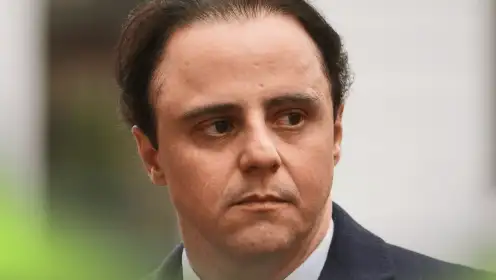FIA admits ‘weakness’ exposed after McLaren raise Verstappen engine cost cap query

Max Verstappen went from pit lane to the podium in Brazil
FIA single seater director Nikolas Tombazis admits that a “weakness” in the current Formula 1 regulations was exposed when McLaren raised a cost cap query over Max Verstappen’s engine change.
Red Bull gave Verstappen a new power unit in Brazil, alongside setup changes to the RB21, to boost his recovery mission. McLaren queried how that would be represented in Red Bull’s F1 cost cap compliance, with Tombazis admitting that it is a tricky subject. However, it is something which will be resolved in the upcoming engine cost cap.
FIA admit ‘weakness’ exposed by Max Verstappen engine change
With Verstappen required to start from the pit lane due to those setup changes ahead of the Grand Prix, Red Bull also took that opportunity to introduce a new power unit. With Verstappen recovering to a P3 finish, McLaren team principal Andrea Stella said that “these kinds of power unit changes challenge the regulations”.
He added, “I will be interested in understanding if the cost of this engine now goes in the cost cap or not.
“If the engine was changed for performance reasons, it should go in the cost cap.”
Stella’s comments indicated that a distinction exists between performance and reliability-related engine changes when it comes to compliance with the F1 cost cap. Former Haas team principal Guenther Steiner confirmed that as he shed more light on the situation via the Red Flags podcast.
“If you change an engine because it is broke or you blow it up, it doesn’t go into the budget cap. It stays in the engine, which is outside of the budget cap.
“But if you put a new engine in, they say the value of the engine should go against the budget cap.”
Tombazis, speaking in a Las Vegas GP press conference, opened up on the complexity of such a topic for the FIA, making it a “weakness” in the current regulations.
“What we’ve not been keen to get involved in, as the FIA at the moment, is a situation where when there’s an engine change, we have to argue with the team or the PU manufacturer whether a bit of telemetry indicates potentially a reliability issue or not,” he said.
“We don’t feel we have the expertise to argue with them whether it’s really a reliability or strategic change. And, again, in some cases it’s obviously in one or the other camp. But when you’re in that crossover area, it would be difficult.
“So this has been a weakness in the current regulations — the combination of Financial plus Technical and Sporting — and it’s been an area where we’ve adopted this approach where we accept these changes without getting into discussion about the impact on the cost cap.”
It is a weakness which shall soon resolve itself though, thanks to the engine-specific cost cap in place for the new creations coming in F1 2026.
How F1 2026 is shaping up
👉 F1 2026: Confirmed teams and power unit suppliers for F1’s huge regulation changes
👉 F1 2026 driver line-up: Who is already confirmed for the 2026 grid?
“However, it has been one of the areas where next year, with the cost cap for the PU manufacturers as well as the teams, this matter is resolved,” Tombazis continued, “because the PU manufacturers would never find it convenient to make a strategic change, because each time it’s going to cost them approximately the cost of an engine — a million, if it’s just the internal combustion or whatever.
“And that will provide a natural mechanism.
“So we think it’s a weakness in the current set of regulations, where there’s no PU cost cap, but we think it gets resolved completely next year. It will stop being a topic of discussion.”
Read next: FIA issues statement after major Felipe Massa $82million legal case update





